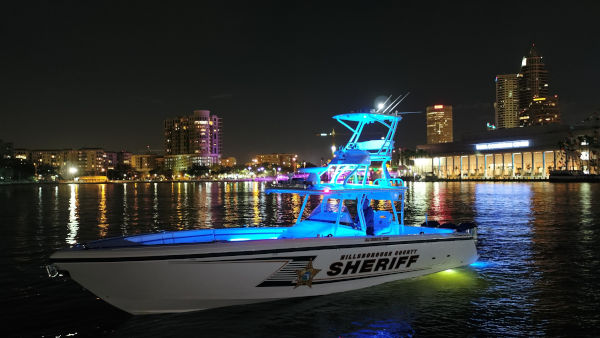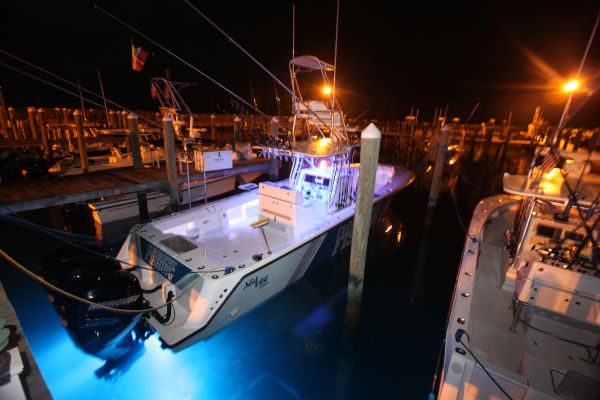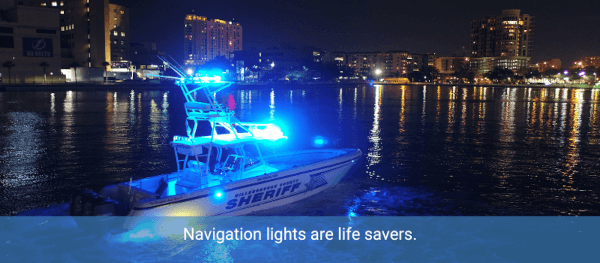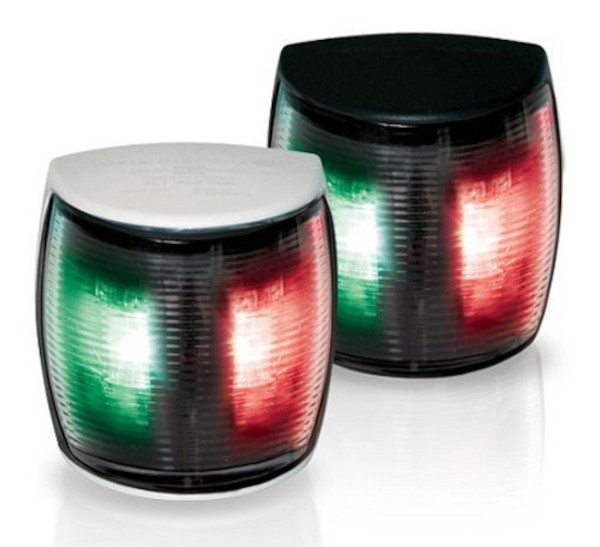Posted by Apex Lighting on 20th Dec 2022
Navigation Lights for Boats: How to Choose Your Ideal Fit
Navigation lights are life savers. They make your boat visible to other boat operators, allowing them to determine your direction and prevent the two vessels from colliding.
For that reason, the U.S. Coast Guard (USCG) requires boats operating in the U.S. to display navigation lights whenever visibility is limited, usually between sunset and sunrise and when the weather is foggy or rainy.
Navigational lights for boats have a red, green, and white color code. The four types of lights and their colors are:
- Sidelights: Red and green
- All-round lights: White
- Stern lights: White
- Masthead lights: White
Different situations require you to display different lights. A boat underway cannot display the same type or number of lights as an anchored boat or one unable to maneuver due to malfunction.
The illuminated arch of light and how many miles away it will be visible from for other boaters is also significant in navigational lighting.
Additionally, navigational lights must shine bright, be energy efficient, be long-lasting, and not be easily damaged by water.
Considering all these points, how do you tell which lights to display? Several factors come into play, which we’ll look at in detail.
1 - Whether Your Boat Is Underway

The ideal navigation lights to display on your boat while it’s underway (when it’s not anchored) are dictated by your boat’s length and whether your vessel is powered by a motor or engine.
Unpowered vessels include sailboats that rely on wind to sail. They also include canoes, kayaks, and rowboats using oars or paddles.
Tip: To determine the length of your boat, measure it in a straight line from the tip to the rear, in feet. Rudders, bowsprits and other attachments aren’t included in the measurement.
After measuring your vessel’s length, you’ll display navigation lights according to the following guidelines.
Powered Boats Measuring up to 39.4 Feet
- One all-round white light visible from 2 Nautical Miles (2NM) away across 360º
- A pair of red and green sidelights visible from 1 Nautical Mile (1NM) away across 112.5º
The all-round white light should be positioned at least 39 inches above the sidelights.
Powered Boats Longer Than 39.4 Feet, but Less Than 65.6 Feet
- A masthead light visible from 2 Nautical Miles (2NM) away across 225º
- A stern light visible from 2 Nautical Miles (2NM) away across 135º
- A pair of green and red lights visible from 1 Nautical Mile (1NM) away across 112.5º
The masthead light should be positioned at least eight feet above the gunnel.
Unpowered Sailboats Longer Than 23 Feet
- A white stern light visible from 2 Nautical Miles (2NM) away across 135º
- A pair of red and green sidelights visible from 1 Nautical Mile (1NM) away at 112.5º
Alternatively, you can display a tricolor light, also known as an all-round light. It consists of three parts: red at port, green at starboard and white at stern. The tricolor light is visible from two miles away.
Unpowered Sailboats Under 23 Feet and Vessels Using Oars or Paddles
You only need to display a white light, such as a flashlight or a lantern, but if possible, display the navigation lights used for sailboats longer than 23 feet.
2 - Whether Your Boat Is Anchored

Recreational boats at anchor don’t require navigational lights unless they’re in a non-designated area like a marina, or if they’re anchored in a narrow channel.
In such a case, your boat needs its navigational lights to be visible to other vessels nearby. The rule applies to both powered and unpowered vessels.
Any anchored boat less than 164 feet long must display an all-round white light at night visible by other boaters from two miles away. Place the light on a masthead or as high as possible for maximum visibility.
If you’re anchored in a crowded anchorage, you can use a cabin or cockpit light in addition to the all-round white light. The additional light will alert other boat operators of your presence if they haven’t noticed your navigation light on top of the mast.
What if your boat is unable to maneuver and avoid another vessel? What are the ideal navigation lights?
If an engine malfunction or a rudder failure leads to such a situation, use these navigational lights:
- For a stationary boat: Display two red all-round lights
- For a moving boat: Display one red portside light, one green starboard light and one stern light
3 - How Well the Lights Perform
When choosing navigation lights to display on your boat, their design will determine:
- How long they’ll last
- Whether they’re waterproof
- How much energy they'll consume
Choose LED navigation lights over incandescent or fluorescent lights. LEDs are the best option due to their outstanding performance in these areas:
Waterproofing
Waterproof LED lights can withstand splashes and other forms of contact with water. It all depends on their Ingress Protection (IP) rating.
IP ratings indicate a light’s level of protection against solids and liquids. The first digit shows the extent an item is protected from solids, such as debris and dust, while the second digit shows its level of protection from liquids.
Therefore, when purchasing waterproof LED lights, look out for the last digit and select those with a rating of 67 or 68, suitable for marine activities.
The table below indicates what various IP ratings signify.
| IP Rating | Level Of Protection |
| 0 | No protection offered |
| 1 | Protection against condensation and falling water drops |
| 2 | Protection against vertical falling water drops up to 15º |
| 3 | Protection against vertical water sprays from up to 60º from all directions |
| 4 | Protection against splashing water from any direction |
| 5 | Protection against low-pressure jets of water from any direction |
| 6 | Protection against high-pressure jets of water from any direction |
| 7 | Protection against immersion in water, 3.3 feet deep, for 30 minutes |
| 8 | Protection against immersion in water under pressure, 9.8 feet deep, for 30 minutes |
Energy-Efficiency, Long Life, and Illumination
LED lights are the preferred option for marine lighting because they consume 75% less energy and last 25 times longer than incandescent lights.
LED lights are replaced once every 15 years, while incandescent lights are replaced every one or two years. As such, LED lights are the most cost-saving.
LED lights also shine bright—exactly what you need navigational lights to do in the dark. This bright illumination is due to their high lumen score (a measure of brightness).
Only a reputable supplier can offer genuine LED navigational lights of such high quality.
Expert Tip: If you’re worried about overnight power consumption by lights when your boat is anchored, choose an LED light that automatically turns off at sunrise.

Apex Lighting Has an Extensive Collection of Navigational Lights for Boats
Apex Lighting makes it easy for you to find navigation lights for your boat at a friendly price that fits your budget.
The company’s extensive collection features all-around lamps, masthead lamps, stern lights, tri-color lamps, starboard and port side lights, and many more to suit your marine needs.
“I purchased port and starboard navigation lights and they came in eight days, in good quality and they work well.” — Lauri A.
Once you make an order, they ship within 3–4 days and offer free ground shipping for orders over $199.
“Great experience, prompt shipment, thank you for helping me get back on the water.” — Henry N.
Avoid boat collisions with quality lighting. Get marine navigation lights from Apex Lighting and light up your whole trip.
Frequently Asked Questions
What qualities should I look for when buying navigational lights for boats?
Look for LED lights with an IP rating of 67 or 68. With such a high rating, they won’t be damaged when they come into contact with water. Also, look for ENERGY STAR labels proving the ability of that LED light to consume less energy.
What factors influence which navigational lights to display on my boat?
- Boat size and mode of power: Its length and whether it’s a powered or unpowered vessel.
- Whether the boat is anchored: An anchored boat will display navigational lights different from those of a moving boat.
Which navigational lights are used?
There are four types:
- Sidelights: A green light on the starboard and red light on the port side
- Stern lights: A white light at the rear end that projects light backward
- Masthead lights: Located above the boat and shines uninterrupted light
- All-round white light: White light that projects at 360º


